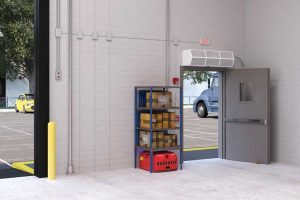
By Michael Coscarelli
Unprecedented market conditions and culture, partly initiated by the pandemic, created new benefits which subsequently led to an increasing demand for air curtains. For example, brick-and-mortar retail stores decentralized their inventories by switching from warehousing to a more diversified approach for in-store storage. Decentralization, especially for national chains, keeps stock closer for buyers, reduces shipping distances, and subsequently, costs. Shipping an online order to an Oregon resident is both cheaper and faster from a Portland store than it is from a warehouse in Nashville, Tennessee. Back door and front door activity for in-person returns of online orders is even more robust and in need of energy conservation using air curtains.
For decades, air curtain benefits for industrial, retail, and institutional applications included energy savings, indoor air comfort, prevention of flying insects, humidity, vehicle emissions, and particle infiltration into occupied spaces.
Likewise, construction in the warehousing industry, which has been on an 11-year growth curve, increased significantly when the pandemic hit America, according to Building Owners and Managers Association (BOMA) International. Previously, online shopping was influencing warehouse expansions. With consumers staying home during lockdowns, online buying skyrocketed, which resulted in higher shipping volumes and more energy loss potential at doors than ever before. An example of this are the challenges of protecting doorways at refrigerated warehouses, which are vital to the food supply chain. Nearly 60 percent of a refrigerated warehouse’s total cost of operation is from energy losses at doorways. Now, with energy costs skyrocketing, it is cutting deeper at the total cost of operation. Unlike conventional warehouses, refrigerated warehouses not only lose energy at open shipping doors, but also at internal freezer doors during forklift traffic.
Can an air curtain make a difference?
Unfilled job openings have increased exponentially over the course of the pandemic. Recently, limited numbers of employees needed to fill a job surplus has made workplace air comfort an important factor for corporate human resources. Employees are more apt to pick and choose employment with as many benefits as possible, and air comfort is one of them. A workplace environment which is warm in the winter and cool in the summer helps retain employees. Air curtains separate the indoor and outdoor environment at open doorways; for example, they can prevent warm air from entering the workplace in summer. In winter, air curtains can not only prevent cold air infiltration through open doorways, but they can also employ electric, steam, or hot water heating with onboard coils to maintain comfortable doorway area temperatures.




